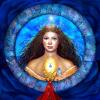 Submitted by Shekhinah on
Submitted by Shekhinah on

by Morten St. George
This is not the first time it is being suggested that parts of the Qur'an (Koran) were authored by an alien. It seems the Qur'an contains scientific information that could not have been known in Muhammad's (Mohammed's) time and that was subsequently proven to be correct. This lies in sharp contrast to biblical science, which has been generally shown to be erroneous.
But the present article has nothing to do with science. It merely relates to a prolonged investigation of medieval mysticism. According to cryptically-written accounts, in the late sixth century A.D. or thereabouts, Elijah the Prophet twice returned to Earth in his chariot, delivering to Judaic scholars in a Babylonian desert, first, the Book of Light (prophetic poems written in Latin), and then the Book of Abraham (a mathematical summary of creation written in Hebrew). Medieval writings insinuate that those two books had a profound impact on Judaism: the Book of Abraham's unrelenting praise of Hebrew led to the resurrection of Hebrew as a living language, and possession of the Book of Light (the luminous presence of the exile) reinforced Jewish resolve against pressure to convert to Islam or Christianity while the textual contents of this book inspired the migration of mystics from the Middle East to specific parts of Europe.
Anyway, the moral of this story is that Muhammad's encounter with the archangel Gabriel may not have been an isolated incident. Out of the secret world of Jewish mysticism (Kabbalah) come signs that around the time of Muhammad the early mystics had similar-type encounters with the prophet Elijah in nearby Babylonia. The prophet and the angel were both described as luminous, and each glorified the Lord in imperious voice. There's more. The Book of Light was a masterpiece of Latin poetry, the Book of Abraham exemplified use of twenty-two letter Hebrew, and the Qur'an set standards for the Arabic language. All three have surprised scholars on linguistic grounds. Beyond this and other considerations, the Qur'an directly mentions the Book of Abraham, though to this day Muslims seem to have little notion about what book the Qur'an is referring to.
The opening sentence of the Book of Abraham reads as follows: "Into thirty-two mysterious paths of wisdom did (he/it) engrave Yah, Lord of the Legions, God of Israel, God of Life, King of Ages, Almighty God, Creator of Good, Dwelling in the Heights, Dwelling in Eternity, Holy Be His Name, and create (his/its) world with three books: written, numerical, and verbal." Medieval mystics correctly identified the numerical rendering as pertaining to the Book of Abraham itself, and they correctly identified the written rendering as pertaining to the Book of Light (deemed written in heaven by the archangel Metatron). For the verbal rendering, however, they concluded that it had to be the Book of Moses, now deemed to have been verbally dictated to Moses on Mount Sinai. But that makes little sense. Moses was too distant in time to be part of singular authorship of the three books. The verbal rendering therefore has to be the Qur'an, verbally transmitted to Muhammad on the Mountain of Light.
The above paragraphs constitute a synthesis of information gathered from dozens of sources. Heavily consulted were the Sefer ha-Bahir, particularly chapters on the Works of the Chariot, and the writings of Gershom Scholem, especially sections that refer to the Revelations of Elijah (another name of the Book of Light). Meanwhile, a vivid description of the desert scene in Babylonia was found in a Spanish translation of Saadia Gaon's Commentary on the Sefer Yetzirah (another name of the Book of Abraham). In contrast to these obscure sources, information on Muhammad and the origins of Islam is widely available on the Internet.
Mystic literature (including variant versions of the Book of Abraham) is contradictory on which book, the Book of Light or the Book of Abraham, was delivered on Elijah's first descent and which one on his second descent. Likewise, the amount of time that transpired between the two descents, whether it was hours, days, or years, is unclear. The Book of Light informs of celestial descent coming after 580 A.D. but is otherwise silent on these issues. Unreliable indications from a later but nonetheless well-informed source give the year 585 A.D. for delivery of the Book of Light (which seems plausible in light of the Geonim of Babylonia beginning in 589 A.D.) and 606 or 607 A.D. for the Book of Abraham. Thus, by these measures, the prophet Elijah preceded the archangel Gabriel.
Morten St. George is an ancient astronaut investigator by life-long hobby, author of the book Incantation of the Law Against Inept Critics: A Guide to Cryptic Thinking, and creator of the websites: Morten St. George and Senderos Secretos de la Sabiduria.
Article Source:http://http://www.articlesphere.com/Article/Muhammad-and-the-Angel-of-Light/235393
- 829 reads